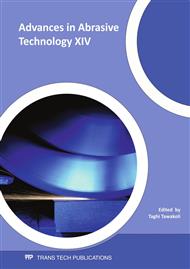p.699
p.707
p.713
p.719
p.725
p.731
p.739
p.745
p.751
Transfer of Nanocarbon Induced by Fine Particle Peening (FPP) Using Carbon-Black/Steel Hybridized Particles
Abstract:
Fine Particle Peening (FPP) treatment, where the surfaces of materials are bombarded with fine shot particles, can transfer shot particle elements on the treated surface. In order to create nanocarbon-transferred surface with FPP treatment, hybridized particles combining steel cores and nanocarbon surface layer are proposed. Mixing with mechanical mortar creates attached layer of carbon-black powders on surface of steel cores, resulting in formation of hybridized particles. FPP using the hybridized particles significantly increases carbon elements on AISI304 steel substrate. This is because of transfer of carbon-black from hybridized particle. Transfer of carbon-black is enhanced when the hybridized particles with high hardness cores are employed. It is revealed that the hybridized particle proposed in the present study is effective to create the modified layer accompanied with transferred nanocarbon.
Info:
Periodical:
Pages:
751-756
Citation:
Online since:
August 2011
Authors:
Keywords:
Price:
Сopyright:
© 2011 Trans Tech Publications Ltd. All Rights Reserved
Share:
Citation:


